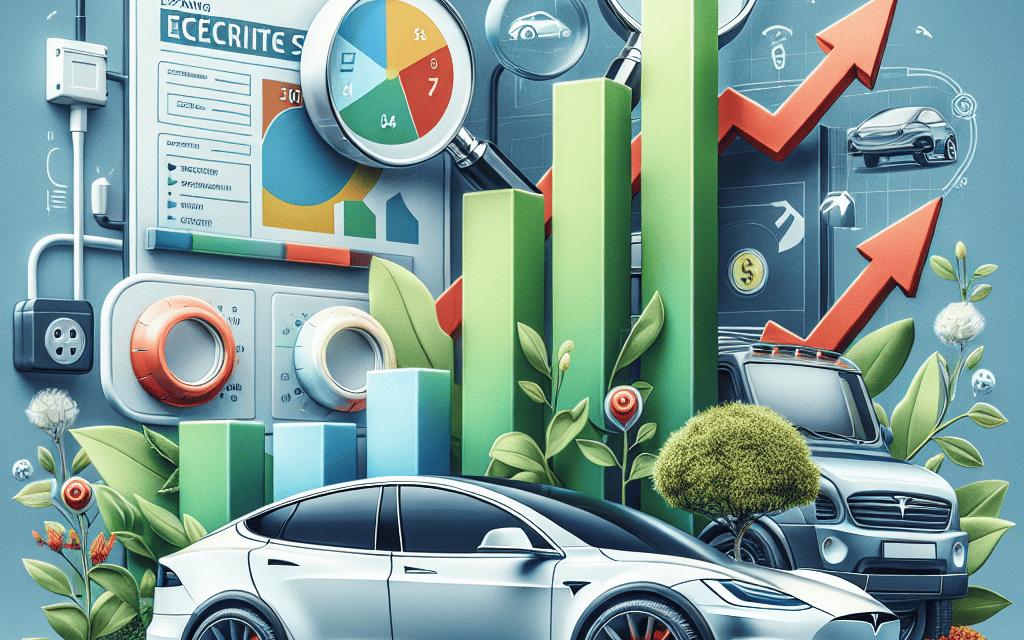“Accelerating Green Profits: Tesla’s EV Sales Credits Drive Forward, Unstoppable.”
Introduction
Tesla’s electric vehicle (EV) sales credits, a significant component of the company’s financial strategy, are poised for expansion rather than elimination. These credits, which Tesla earns by producing zero-emission vehicles, have historically played a crucial role in bolstering the company’s profitability. As global regulatory environments increasingly favor sustainable transportation, the demand for such credits is expected to rise. This expansion is driven by stricter emissions targets and the growing adoption of EVs by traditional automakers, who often purchase credits to comply with environmental regulations. Consequently, Tesla’s position as a leader in the EV market not only enhances its competitive edge but also solidifies its financial foundation through the strategic sale of these credits.
Understanding Tesla’s EV Sales Credits: Expansion Over Elimination
Tesla’s electric vehicle (EV) sales credits have long been a topic of interest and debate within the automotive industry. These credits, which are earned by producing zero-emission vehicles, have played a significant role in Tesla’s financial strategy, allowing the company to sell them to other automakers that need to offset their own emissions. As the global push for sustainable transportation intensifies, the future of these credits is becoming increasingly relevant. Contrary to some expectations that these credits might be phased out, recent developments suggest that they are set for expansion rather than elimination.
To understand the significance of this expansion, it is essential to consider the broader context of environmental regulations. Governments worldwide are tightening emissions standards to combat climate change, and many countries are setting ambitious targets for reducing carbon footprints. In this regulatory environment, EV sales credits have become a valuable asset for automakers. They provide a financial incentive for companies to accelerate their transition to electric vehicles, thereby supporting global sustainability goals.
Tesla, as a pioneer in the EV market, has been at the forefront of this transition. The company’s ability to generate substantial revenue from selling these credits has been a key factor in its financial success. In recent years, Tesla has consistently reported profits, with sales of regulatory credits contributing significantly to its bottom line. This revenue stream has enabled Tesla to reinvest in research and development, expand its production capacity, and maintain its competitive edge in the rapidly evolving automotive landscape.
Moreover, the expansion of EV sales credits aligns with the increasing demand for electric vehicles. As consumer preferences shift towards more environmentally friendly options, automakers are under pressure to enhance their EV offerings. This shift is not only driven by regulatory requirements but also by a growing awareness of the environmental impact of traditional internal combustion engines. Consequently, the demand for EV sales credits is expected to rise, providing Tesla with continued opportunities to capitalize on its early investments in electric vehicle technology.
In addition to regulatory and market dynamics, technological advancements are also contributing to the expansion of EV sales credits. Innovations in battery technology, charging infrastructure, and vehicle design are making electric vehicles more accessible and appealing to consumers. As these technologies continue to evolve, the cost of producing electric vehicles is expected to decrease, further incentivizing automakers to increase their EV production. This, in turn, will likely lead to a greater reliance on sales credits as a means of achieving compliance with emissions standards.
Furthermore, the expansion of EV sales credits is not limited to Tesla alone. Other automakers are also recognizing the value of these credits and are investing in their own electric vehicle programs. This trend is fostering a more competitive market, where companies are striving to enhance their EV portfolios and reduce their reliance on traditional vehicles. As a result, the overall market for EV sales credits is poised for growth, benefiting not only Tesla but the entire automotive industry.
In conclusion, Tesla’s EV sales credits are set for expansion rather than elimination, driven by a confluence of regulatory, market, and technological factors. As governments worldwide continue to prioritize sustainability, the demand for electric vehicles and the associated credits is expected to increase. This expansion presents significant opportunities for Tesla and other automakers to advance their electric vehicle initiatives, ultimately contributing to a more sustainable future for the automotive industry.
The Impact of Expanding EV Sales Credits on Tesla’s Market Strategy
Tesla’s electric vehicle (EV) sales credits have long been a significant component of the company’s financial strategy, providing a substantial boost to its revenue stream. As the global automotive industry continues to shift towards sustainable energy solutions, the expansion of these credits is poised to play an even more critical role in Tesla’s market strategy. Rather than facing elimination, these credits are set for expansion, which could have profound implications for Tesla’s competitive positioning and overall market dynamics.
To understand the impact of expanding EV sales credits on Tesla’s market strategy, it is essential to first consider the role these credits have played historically. Tesla has benefited from selling regulatory credits to other automakers who need them to comply with emissions regulations. This practice has not only bolstered Tesla’s financial performance but also allowed the company to reinvest in research and development, further enhancing its technological edge. As governments worldwide intensify their focus on reducing carbon emissions, the demand for such credits is expected to increase, providing Tesla with an even greater opportunity to capitalize on this revenue stream.
Moreover, the expansion of EV sales credits aligns with Tesla’s broader mission to accelerate the world’s transition to sustainable energy. By leveraging these credits, Tesla can continue to invest in scaling its production capabilities and expanding its global footprint. This strategic focus on growth is crucial as the company faces increasing competition from both established automakers and new entrants in the EV market. The additional revenue from expanded credits can support Tesla’s efforts to maintain its leadership position by funding innovations in battery technology, autonomous driving, and energy storage solutions.
In addition to supporting Tesla’s growth initiatives, the expansion of EV sales credits could also influence the company’s pricing strategy. With increased revenue from credits, Tesla may have more flexibility to adjust its pricing models, potentially making its vehicles more accessible to a broader range of consumers. This could be particularly advantageous in emerging markets where price sensitivity is a significant factor in consumer decision-making. By offering more competitively priced vehicles, Tesla can capture a larger share of these markets, further solidifying its global presence.
Furthermore, the expansion of EV sales credits may also impact Tesla’s relationships with other automakers. As the demand for credits grows, Tesla could explore new partnerships or agreements with companies seeking to meet regulatory requirements. These collaborations could open up additional revenue streams and create opportunities for knowledge sharing and joint ventures, ultimately benefiting the broader EV ecosystem.
However, it is important to consider potential challenges associated with the expansion of EV sales credits. Regulatory changes or shifts in government policies could impact the availability and value of these credits, introducing an element of uncertainty into Tesla’s financial planning. Additionally, as more automakers develop their own EV capabilities, the demand for credits may fluctuate, requiring Tesla to continuously adapt its strategy to changing market conditions.
In conclusion, the expansion of EV sales credits is set to play a pivotal role in Tesla’s market strategy, offering opportunities for growth, innovation, and increased market penetration. By capitalizing on these credits, Tesla can reinforce its position as a leader in the EV industry while advancing its mission to promote sustainable energy solutions. As the landscape of the automotive industry continues to evolve, Tesla’s ability to navigate these changes will be crucial in maintaining its competitive edge and driving long-term success.
How Tesla’s EV Sales Credits Expansion Influences the Automotive Industry
Tesla’s electric vehicle (EV) sales credits have long been a significant factor in the company’s financial strategy, providing a substantial boost to its revenue stream. These credits, which are earned by producing zero-emission vehicles, can be sold to other automakers that need to offset their own emissions. As the automotive industry continues to shift towards sustainable practices, the role of these credits is set for expansion rather than elimination, influencing the broader market dynamics in profound ways.
To understand the impact of Tesla’s EV sales credits, it is essential to consider the regulatory environment that necessitates their existence. Governments worldwide have implemented stringent emissions standards to combat climate change, compelling automakers to reduce their carbon footprint. For many traditional car manufacturers, meeting these standards solely through their own production is challenging. Consequently, they turn to companies like Tesla, which consistently exceed these requirements, to purchase credits and comply with regulations. This system not only incentivizes the production of cleaner vehicles but also provides a financial lifeline to companies like Tesla, which can reinvest the proceeds into further innovation and expansion.
The expansion of Tesla’s EV sales credits is poised to have a ripple effect across the automotive industry. As more countries adopt aggressive emissions targets, the demand for these credits is likely to increase. This scenario presents a dual opportunity for Tesla: it can continue to capitalize on its early investment in electric vehicle technology while simultaneously encouraging other manufacturers to accelerate their transition to greener alternatives. By maintaining a robust portfolio of credits, Tesla effectively positions itself as both a leader in sustainable transportation and a pivotal player in the regulatory compliance landscape.
Moreover, the expansion of EV sales credits underscores the growing importance of collaboration and competition in the automotive sector. Traditional automakers, recognizing the necessity of aligning with environmental standards, are increasingly investing in their own electric vehicle lines. However, until these efforts reach full maturity, the reliance on credits from companies like Tesla remains a critical component of their strategy. This dynamic fosters a competitive environment where innovation is paramount, driving advancements in battery technology, vehicle design, and overall efficiency.
In addition to influencing corporate strategies, the expansion of Tesla’s EV sales credits also has implications for consumers. As automakers strive to meet emissions targets, the increased availability of electric vehicles is likely to result in more competitive pricing and a broader range of options for consumers. This shift not only makes electric vehicles more accessible but also accelerates the adoption of sustainable transportation solutions on a global scale. Consequently, the automotive industry is poised to undergo a transformation that prioritizes environmental responsibility without compromising consumer choice.
In conclusion, the expansion of Tesla’s EV sales credits represents a significant development in the automotive industry, with far-reaching implications for manufacturers, consumers, and the environment. By leveraging its position as a leader in electric vehicle production, Tesla not only strengthens its financial standing but also plays a crucial role in shaping the future of transportation. As the demand for cleaner vehicles continues to grow, the influence of these credits will likely extend beyond regulatory compliance, driving innovation and fostering a more sustainable automotive landscape.
Financial Implications of Tesla’s EV Sales Credits Expansion

Tesla’s electric vehicle (EV) sales credits have long been a significant component of the company’s financial strategy, providing a substantial boost to its revenue streams. As the global automotive industry continues to shift towards sustainable energy solutions, these credits have become increasingly valuable. Recently, there has been speculation about the potential elimination of these credits; however, current trends suggest that an expansion, rather than elimination, is on the horizon. This development carries profound financial implications for Tesla and the broader EV market.
To understand the significance of this expansion, it is essential to consider the role that EV sales credits play in Tesla’s financial ecosystem. These credits are part of regulatory frameworks designed to incentivize the production and sale of zero-emission vehicles. Automakers that produce more EVs than required can sell their excess credits to other manufacturers that fall short of regulatory standards. For Tesla, which exclusively produces electric vehicles, this has translated into a lucrative revenue stream, bolstering its financial performance and enabling further investment in innovation and infrastructure.
The potential expansion of EV sales credits is driven by several factors. Firstly, governments worldwide are intensifying their efforts to combat climate change, leading to stricter emissions regulations. As a result, the demand for EV credits is expected to rise, providing Tesla with more opportunities to capitalize on its surplus. Moreover, as more traditional automakers transition to electric vehicles, the competition for these credits will likely increase, further enhancing their value.
In addition to regulatory pressures, consumer demand for electric vehicles is surging. This shift is fueled by growing environmental awareness, advancements in battery technology, and the increasing affordability of EVs. As Tesla continues to lead the market with its innovative offerings, the company is well-positioned to benefit from this trend. The expansion of EV sales credits will not only support Tesla’s financial growth but also reinforce its competitive advantage in the industry.
Furthermore, the expansion of these credits aligns with Tesla’s long-term strategic goals. The company has consistently prioritized sustainability and innovation, and the additional revenue from expanded credits can be reinvested into research and development. This reinvestment will enable Tesla to accelerate the development of new technologies, such as autonomous driving and energy storage solutions, thereby maintaining its leadership position in the EV market.
While the expansion of EV sales credits presents numerous opportunities, it also poses certain challenges. The increased reliance on these credits could expose Tesla to regulatory changes and market fluctuations. Therefore, it is crucial for the company to maintain a diversified revenue model and continue to innovate in order to mitigate potential risks. By doing so, Tesla can ensure its financial stability and sustain its growth trajectory.
In conclusion, the expansion of Tesla’s EV sales credits is poised to have significant financial implications for the company and the broader automotive industry. As regulatory pressures and consumer demand for electric vehicles continue to rise, these credits will play an increasingly vital role in shaping the market dynamics. For Tesla, this expansion represents an opportunity to reinforce its financial position, drive innovation, and maintain its competitive edge. However, it is imperative for the company to navigate potential challenges and remain adaptable in an ever-evolving landscape. Through strategic planning and continued investment in sustainable technologies, Tesla can capitalize on the expansion of EV sales credits and contribute to a greener future.
Tesla’s Role in Shaping Future EV Sales Credit Policies
Tesla has long been a pioneer in the electric vehicle (EV) industry, not only through its innovative technology and design but also by playing a significant role in shaping policies that govern the sector. One of the most impactful areas where Tesla has influenced policy is in the realm of EV sales credits. These credits have been instrumental in promoting the adoption of electric vehicles by making them more financially accessible to consumers. As the global push towards sustainable transportation intensifies, Tesla’s involvement in the expansion of EV sales credits is set to grow, rather than diminish.
Initially, EV sales credits were introduced as a means to incentivize manufacturers to produce more environmentally friendly vehicles. These credits allowed companies like Tesla to offset the costs associated with developing cutting-edge technology, thereby making electric vehicles more competitive with traditional internal combustion engine vehicles. Over time, these credits have not only supported Tesla’s growth but have also encouraged other automakers to enter the EV market, fostering a more competitive and innovative industry landscape.
As governments worldwide recognize the urgent need to reduce carbon emissions, the expansion of EV sales credits is becoming a focal point in policy discussions. Tesla, with its established track record and market leadership, is poised to play a crucial role in these discussions. The company’s experience and success in leveraging these credits provide valuable insights into how such policies can be structured to maximize their effectiveness. Moreover, Tesla’s commitment to sustainability aligns with the broader goals of these policies, making it a key stakeholder in shaping their future direction.
Furthermore, the expansion of EV sales credits is not merely about increasing the number of electric vehicles on the road. It also involves addressing the broader ecosystem that supports EV adoption, including charging infrastructure, battery technology, and renewable energy integration. Tesla’s comprehensive approach to these areas positions it as a leader in advocating for policies that consider the entire lifecycle of electric vehicles. By promoting a holistic view of EV adoption, Tesla can help ensure that sales credits are designed to support long-term sustainability goals.
In addition to influencing policy at the governmental level, Tesla’s role in expanding EV sales credits extends to its interactions with other automakers. As a company that has successfully navigated the challenges of scaling EV production, Tesla can offer valuable lessons to its peers. By sharing its expertise and advocating for policies that benefit the entire industry, Tesla can help create a more collaborative environment that accelerates the transition to electric mobility.
Moreover, as the EV market continues to evolve, the criteria for earning sales credits are likely to become more stringent. This shift will require automakers to innovate continuously and improve the efficiency and sustainability of their vehicles. Tesla’s ongoing investment in research and development positions it well to meet these evolving standards and to help shape the criteria that will define future sales credit policies.
In conclusion, Tesla’s role in shaping future EV sales credit policies is set for expansion, not elimination. By leveraging its experience, advocating for comprehensive policy frameworks, and fostering industry collaboration, Tesla is poised to influence the direction of these policies significantly. As the world moves towards a more sustainable future, Tesla’s contributions will be vital in ensuring that EV sales credits continue to drive innovation and adoption in the electric vehicle industry.
Comparing Tesla’s EV Sales Credits Strategy with Competitors
Tesla’s strategy regarding electric vehicle (EV) sales credits has long been a topic of interest and debate within the automotive industry. As the company continues to expand its market share and influence, its approach to leveraging these credits is set for expansion rather than elimination. This strategy not only distinguishes Tesla from its competitors but also highlights the company’s forward-thinking approach in a rapidly evolving market.
To understand Tesla’s position, it is essential to first consider the role of EV sales credits in the automotive industry. These credits are part of regulatory frameworks designed to encourage the production and sale of zero-emission vehicles. Automakers that produce more electric vehicles than required can sell their excess credits to other manufacturers that fall short of regulatory standards. This system incentivizes the production of cleaner vehicles and provides a financial boost to companies like Tesla, which have consistently exceeded regulatory requirements.
Tesla’s adept use of EV sales credits has been a significant factor in its financial success. The company has generated substantial revenue by selling these credits to other automakers, thereby bolstering its bottom line and enabling further investment in innovation and expansion. While some critics argue that reliance on sales credits is unsustainable, Tesla’s strategy suggests otherwise. By continually increasing its production of electric vehicles, Tesla not only secures its position as a leader in the EV market but also ensures a steady stream of revenue from sales credits.
In contrast, many of Tesla’s competitors have struggled to match its success in this area. Traditional automakers, often burdened by legacy systems and slower adaptation to electric vehicle production, find themselves purchasing credits from Tesla to meet regulatory requirements. This dynamic underscores the competitive advantage Tesla holds, as it not only benefits financially from these transactions but also reinforces its reputation as a pioneer in the electric vehicle sector.
Moreover, Tesla’s strategy is set for expansion as the company continues to innovate and diversify its offerings. With plans to introduce new models and increase production capacity, Tesla is poised to generate even more sales credits in the future. This expansion aligns with global trends towards stricter emissions regulations and increased demand for sustainable transportation solutions. As more countries implement policies to reduce carbon emissions, the market for EV sales credits is likely to grow, providing Tesla with further opportunities to capitalize on its leadership position.
While some automakers are beginning to catch up, investing heavily in electric vehicle technology and infrastructure, Tesla’s head start gives it a distinct advantage. The company’s commitment to innovation, exemplified by its advancements in battery technology and autonomous driving, ensures that it remains at the forefront of the industry. This forward-thinking approach not only secures Tesla’s competitive edge but also positions it to continue benefiting from the evolving regulatory landscape.
In conclusion, Tesla’s strategy regarding EV sales credits is characterized by expansion rather than elimination. By leveraging its leadership in electric vehicle production and innovation, Tesla not only generates significant revenue from sales credits but also strengthens its position in a competitive market. As the automotive industry continues to evolve, Tesla’s approach serves as a model for how companies can successfully navigate the challenges and opportunities presented by the transition to sustainable transportation.
The Environmental Benefits of Expanding Tesla’s EV Sales Credits
Tesla’s electric vehicle (EV) sales credits have long been a topic of discussion among industry experts and environmental advocates alike. These credits, which are earned by automakers that produce zero-emission vehicles, have played a crucial role in promoting the adoption of electric vehicles. As the world grapples with the pressing need to reduce carbon emissions and combat climate change, the expansion of Tesla’s EV sales credits emerges as a significant development with far-reaching environmental benefits.
To begin with, the expansion of Tesla’s EV sales credits is poised to accelerate the transition to sustainable transportation. By providing financial incentives to automakers, these credits encourage the production and sale of electric vehicles, thereby reducing the reliance on fossil fuels. This shift is essential in curbing greenhouse gas emissions, which are a major contributor to global warming. As more automakers strive to earn these credits, the market for electric vehicles is likely to grow, leading to increased consumer adoption and a subsequent reduction in the carbon footprint of the transportation sector.
Moreover, the expansion of Tesla’s EV sales credits can stimulate innovation within the automotive industry. As companies compete to earn these credits, they are incentivized to invest in research and development to create more efficient and affordable electric vehicles. This competition can lead to technological advancements that not only improve the performance and range of electric vehicles but also make them more accessible to a broader audience. Consequently, the widespread availability of affordable electric vehicles can further drive their adoption, amplifying the environmental benefits.
In addition to fostering innovation, the expansion of Tesla’s EV sales credits can have a positive impact on air quality. Traditional internal combustion engine vehicles emit pollutants that contribute to air pollution, which poses significant health risks to humans and the environment. By promoting the adoption of electric vehicles, which produce zero tailpipe emissions, these credits can help reduce air pollution levels, leading to cleaner air and improved public health outcomes. This is particularly important in urban areas, where vehicle emissions are a major source of air pollution.
Furthermore, the expansion of Tesla’s EV sales credits aligns with global efforts to achieve carbon neutrality. Many countries have set ambitious targets to reduce carbon emissions and transition to renewable energy sources. By supporting the growth of the electric vehicle market, these credits can help nations meet their climate goals and reduce their dependence on fossil fuels. This alignment with international climate objectives underscores the importance of expanding EV sales credits as a tool for environmental progress.
While some critics argue that the reliance on sales credits may create an uneven playing field in the automotive industry, it is important to recognize the broader environmental benefits that these credits can deliver. By incentivizing the production and adoption of electric vehicles, Tesla’s EV sales credits contribute to a cleaner, more sustainable future. As the world continues to confront the challenges of climate change, the expansion of these credits represents a proactive step towards reducing carbon emissions and promoting environmental stewardship.
In conclusion, the expansion of Tesla’s EV sales credits is not merely a financial mechanism for automakers; it is a catalyst for environmental change. By accelerating the transition to electric vehicles, stimulating innovation, improving air quality, and supporting global climate goals, these credits offer a pathway to a more sustainable and environmentally friendly transportation landscape. As such, their expansion should be viewed as a positive development in the ongoing effort to combat climate change and protect our planet for future generations.
Q&A
1. **What are EV sales credits?**
EV sales credits are incentives provided by governments to encourage the production and purchase of electric vehicles (EVs). These credits can be traded between automakers, allowing companies that produce more EVs to sell their excess credits to those that produce fewer.
2. **How do EV sales credits benefit Tesla?**
Tesla benefits from EV sales credits by selling excess credits to other automakers that need them to comply with regulatory requirements. This has historically provided Tesla with significant revenue.
3. **Why are Tesla’s EV sales credits set for expansion?**
Tesla’s EV sales credits are set for expansion due to increasing regulatory pressures on automakers to reduce emissions and the growing global push towards electric vehicles, which increases the demand for these credits.
4. **What impact does the expansion of EV sales credits have on Tesla’s financials?**
The expansion of EV sales credits can positively impact Tesla’s financials by providing additional revenue streams, which can be used to fund further innovation and expansion efforts.
5. **Are there any risks associated with relying on EV sales credits?**
Yes, there are risks associated with relying on EV sales credits, such as potential changes in regulations or market conditions that could reduce the demand for credits, impacting Tesla’s revenue from this source.
6. **How do other automakers view the expansion of EV sales credits?**
Other automakers may have mixed views on the expansion of EV sales credits. While it provides a compliance mechanism, it also highlights the pressure to increase their own EV production to avoid purchasing credits.
7. **What is the future outlook for EV sales credits in the automotive industry?**
The future outlook for EV sales credits in the automotive industry is likely to see continued importance as governments worldwide push for stricter emissions standards and increased EV adoption, although the specifics may vary by region and regulatory changes.
Conclusion
Tesla’s electric vehicle (EV) sales credits are poised for expansion rather than elimination, reflecting the growing emphasis on sustainable transportation and regulatory support for clean energy initiatives. As governments worldwide continue to implement stricter emissions standards and incentivize the adoption of zero-emission vehicles, Tesla stands to benefit from an increased allocation of sales credits. These credits not only enhance Tesla’s financial performance by providing a significant revenue stream but also reinforce its competitive advantage in the EV market. The expansion of sales credits underscores the ongoing transition towards greener automotive solutions and positions Tesla to capitalize on the accelerating shift towards electric mobility.





